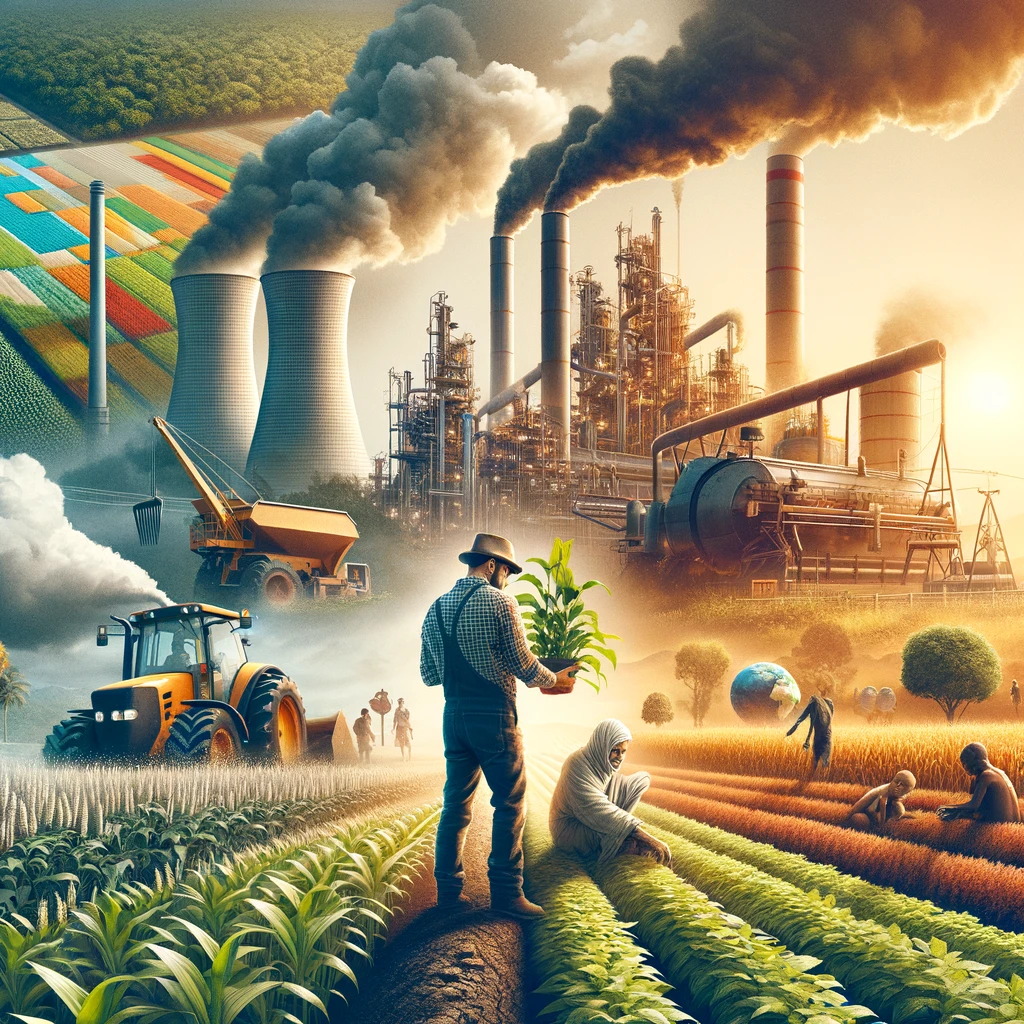
The agriculture sector, includes growing, processing, and delivering food, provides jobs and income for more than a billion people worldwide. However, the sector is grappling with numerous challenges, including food scarcity, limited access to food, and affordability issues. Additionally, intensive agricultural practices have led to environmental degradation, social issues, and health risks.
The United Nations Food and Agriculture Organization (FAO) addresses these concerns in its report, “The State of Food and Agriculture 2023.” This report dig into the ‘hidden costs’ associated with current agrifood systems, highlighting their staggering global impact—totaling nearly $12.7 trillion, equivalent to almost 10% of the world’s GDP. These hidden costs are classified into three major categories: health-related costs driven by poor dietary patterns, environmental costs from emissions and land use, and social costs linked to poverty and productivity losses due to undernourishment.
Hidden Costs of Agrifood Systems in India
The Magnitude of Hidden Costs
The staggering $12.7 trillion global price tag of these hidden costs, in the context of India, the report reveals that hidden costs from agrifood systems amount to about USD 1.1 trillion, equating to nearly 8.8% of the world’s GDP, making it the third largest contributor after China and the United States. The breakdown of these hidden costs is as follows:
- Burden of Disease: The largest share (60%) of hidden costs in India comes from the burden of disease. The predominance of health-related costs, driven by dietary patterns leading to non-communicable diseases and labor productivity losses.
- Environmental Cost: The environmental toll, underscored by the degradation inflicted by intensive agricultural practices. Approximately 13% of hidden costs stem from the environmental cost of nitrogen emissions in the country.
- Social Cost of Poverty: The societal impact, particularly in India, where the agrifood system’s hidden costs soar to approximately USD 1.1 trillion, revealing the urgent need for transformative policies. Around 14% of hidden costs are attributed to the social cost of poverty among agrifood workers in India.
Impact on Society
Collapse of Indigenous Systems: Intensive agriculture in India is causing big problems for traditional farming ways. Instead of using local seeds and methods, farmers are now using seeds from big companies and lots of chemicals. This change is making farmers lose their control over seeds and knowledge. They’re also growing fewer types of crops, which isn’t good for stability or the environment. For example, in the Garhwal Himalayan region, there’s a traditional farming method called Barahnaja, where farmers grow 12 different crops in a year.
Increased Debt: Because of these changes, farmers are also getting into more debt. Before, they didn’t have to buy expensive seeds and chemicals. But now, they do, and it’s making them poorer. In just 20 years, from 1992 to 2013, the debt of a farmer’s household in India went up by 630%.
Low Income: Farmers aren’t making much money anymore. On average, a farming family only makes about ₹10,816 per month.
Impact on Ecology
Soil Fertility Decline: The soil is getting worse because of intensive farming. When farmers only grow one crop over and over without changing, it sucks up all the same nutrients from the soil.
Excessive Groundwater Use: Farmers in India use a lot of water to grow crops. But they’re taking too much water from underground, which is hurting the environment.
Impact on Health
Rice and Sugarcane Cultivation: Growing lots of rice and sugarcane is bad for the environment. It hurts biodiversity, makes water and air dirty, and puts too much pressure on groundwater.
The agrifood systems, fundamental to sustaining jobs and livelihoods for over a billion individuals, are now at a crossroads due to their hidden environmental, social, and health costs. The United Nations Food and Agriculture Organization (FAO) in its “State of Food and Agriculture 2023” report, highlights these concealed expenses, quantifying them at a staggering $12.7 trillion globally, which is almost 10% of the world GDP. These costs encompass:
- Environmental repercussions from emissions, water use, and land-use changes.
- Health impacts stemming from unhealthy dietary patterns leading to productivity losses.
- Social ramifications, particularly poverty and productivity losses due to undernourishment.
This underlines the urgent necessity for a transformative approach in agrifood systems, emphasizing the integration of these hidden costs into decision-making processes to foster sustainable, healthy, and equitable food systems.
Global Perspective
Globally, the agrifood systems bear a hidden toll on both the economy and human well-being, with the FAO report revealing that 73% of these costs arise from dietary patterns causing non-communicable diseases (NCDs) and productivity losses. The environmental costs, notably from agricultural practices, account for more than 20% of these hidden costs, equivalent to a third of the agricultural value added. This scenario presents a critical challenge, necessitating a global effort towards reevaluating and transforming agrifood systems to mitigate these hidden costs effectively.
India’s Agrifood Challenge
India faces a unique set of challenges within its agrifood systems, with hidden costs amounting to approximately USD 1.1 trillion, making it the third largest globally. The burden of disease from dietary patterns contributes to 60% of these costs, followed by social costs of poverty (14%) and environmental costs from nitrogen emissions (13%). This underscores the urgent need for India to repurpose its support towards agrifood systems that are not only economically viable but also environmentally sustainable and socially equitable.
Path Towards Sustainable Agriculture
The path towards sustainable agriculture necessitates embracing innovative practices and policy reforms. These include promoting crop diversification, adopting precision irrigation techniques, and implementing variable rate fertilization to tailor nutrient supply according to crop needs. These measures, coupled with government policy reforms, can significantly reduce the hidden costs associated with agrifood systems by enhancing environmental resilience, improving health outcomes, and ensuring social equity within the agricultural sector.
Filling the Gap
The FAO’s true cost accounting approach offers a comprehensive framework for addressing the hidden costs of agrifood systems. By evaluating the environmental, social, health, and economic costs and benefits, this approach enables stakeholders to make informed decisions that prioritize sustainability and equity. Implementing true cost accounting can bridge the gap towards an equitable agrifood future, ensuring that the industry’s practices are aligned with the principles of intergenerational, intragenerational, and interspecies justice.
Way Forward of Minimizing Hidden Costs in Indian Agrifood Systems
Crop Diversification
Encourage farmers to grow a variety of crops and rotate them regularly. This helps keep the soil healthy, lowers the risk of pests and diseases, and makes farming more resilient.
Climate-Resilient Crops
Combine traditional farming knowledge with modern science to find and use crops that can handle local weather conditions. For example, finding and spreading drought-tolerant maize in Africa helped many farmers.
Precision Irrigation
Making the most out of water by using methods like drip and sprinkler irrigation. This saves water and protects the environment.
Variable Rate Fertilization
Adjust the amount of fertilizer used based on what each part of the field needs. This can be done by testing the soil, using technology, and paying attention to the needs of each crop.
Government Policy Changes
Governments can help by changing taxes, giving subsidies, and making new laws. This can help both public and private groups work together better and handle challenges in farming.
Fairness in Agrifood Business
Intergenerational Justice: Deal with past problems caused by farming and make things right.
Intragenerational Justice: Make sure resources are shared fairly within the same generation and farmers are paid fairly.
Interspecies Justice: Protect all living things and keep biodiversity safe.
FAO’s True Cost Accounting Approach
Follow the FAO’s way of counting all the costs and benefits of farming. This includes looking at the environment, society, health, and money. This can help regulate how businesses farm and sell their products.
Conclusion
In the face of the daunting challenges presented by the hidden costs of our agrifood systems, it is incumbent upon us, to spearhead the transformation towards sustainability and equity. The insights provided in the article not only underscore the urgency of addressing these systemic issues but also illuminate the path forward through innovative practices and policy reforms. It is imperative to internalize these lessons and envision a future where our agrifood systems bolster health, environment, and social justice. Let this understanding guide our preparation and future actions, making us architects of a resilient and equitable food system, capable of sustaining not just the present but future generations. This journey of transformation is not just a professional obligation but a moral imperative to ensure a just and sustainable world.

